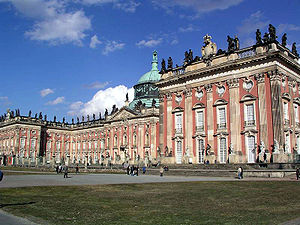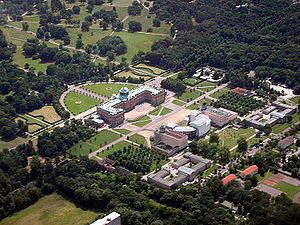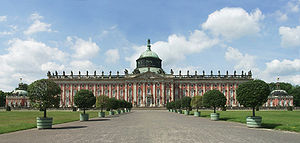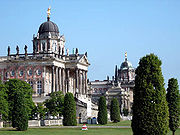
New Palace (Potsdam)
Encyclopedia

Sanssouci Park
Sanssouci Park is a large park surrounding Sanssouci Palace in Potsdam, Germany. Following the terracing of the vineyard and the completion of the palace, the surroundings were included in the structure. A baroque flower garden with lawns, flower beds, hedges and trees was created. In the hedge...
in Potsdam
Potsdam
Potsdam is the capital city of the German federal state of Brandenburg and part of the Berlin/Brandenburg Metropolitan Region. It is situated on the River Havel, southwest of Berlin city centre....
, Germany
Germany
Germany , officially the Federal Republic of Germany , is a federal parliamentary republic in Europe. The country consists of 16 states while the capital and largest city is Berlin. Germany covers an area of 357,021 km2 and has a largely temperate seasonal climate...
. The building was begun in 1763, after the end of the Seven Years' War
Seven Years' War
The Seven Years' War was a global military war between 1756 and 1763, involving most of the great powers of the time and affecting Europe, North America, Central America, the West African coast, India, and the Philippines...
, under Frederick the Great
Frederick II of Prussia
Frederick II was a King in Prussia and a King of Prussia from the Hohenzollern dynasty. In his role as a prince-elector of the Holy Roman Empire, he was also Elector of Brandenburg. He was in personal union the sovereign prince of the Principality of Neuchâtel...
and was completed in 1769. It is considered to be the last great Prussia
Prussia
Prussia was a German kingdom and historic state originating out of the Duchy of Prussia and the Margraviate of Brandenburg. For centuries, the House of Hohenzollern ruled Prussia, successfully expanding its size by way of an unusually well-organized and effective army. Prussia shaped the history...
n baroque palace.
History

Seven Years' War
The Seven Years' War was a global military war between 1756 and 1763, involving most of the great powers of the time and affecting Europe, North America, Central America, the West African coast, India, and the Philippines...
, to celebrate Prussia’s success. The war is also variably referred to as the Third Silesian War, owing to the dispute over Silesia
Silesia
Silesia is a historical region of Central Europe located mostly in Poland, with smaller parts also in the Czech Republic, and Germany.Silesia is rich in mineral and natural resources, and includes several important industrial areas. Silesia's largest city and historical capital is Wrocław...
. In an architectural form, Frederick the Great sought to demonstrate the power and glories of Prussia attributing it as fanfaronade, an excess of splendor in marble, stone and gilt.
For the King, the New Palace was not a principal residence, but a display for the reception of important royals and dignitaries. Of the over 200 rooms, four principal gathering rooms and a theater were available for royal functions, balls and state occasions. During his occasional stays at the palace, Frederick occupied a suite of rooms at the southern end of the building, composed of two antechambers, a study, a concert room, a dining salon and a bedroom, among others.
After the death of Frederick the Great in 1786, the New Palace fell into disuse and was rarely occupied as a residence or entertainment venue. However, starting in 1859 it became the summer residence of the German Crown Prince, Frederick William, later German Emperor Frederick III
Frederick III, German Emperor
Frederick III was German Emperor and King of Prussia for 99 days in 1888, the Year of the Three Emperors. Friedrich Wilhelm Nikolaus Karl known informally as Fritz, was the only son of Emperor William I and was raised in his family's tradition of military service...
. The palace was the preferred residence of Frederick and his empress, Victoria
Victoria, Princess Royal
The Princess Victoria, Princess Royal was the eldest child of Queen Victoria of the United Kingdom and Prince Albert. She was created Princess Royal of the United Kingdom in 1841. She became German Empress and Queen of Prussia by marriage to German Emperor Frederick III...
, throughout the 99 Days’ Reign. During the short reign of Frederick III, the palace was renamed Friedrichskron Palace (Schloß Friedrichskron) and a moat was dug around the palace. The ascension of William II
William II, German Emperor
Wilhelm II was the last German Emperor and King of Prussia, ruling the German Empire and the Kingdom of Prussia from 15 June 1888 to 9 November 1918. He was a grandson of the British Queen Victoria and related to many monarchs and princes of Europe...
saw renovation and restoration within the palace being carried out with the installation of steam heating, bathrooms in state apartments and electrification of the chandeliers which Frederick the Great had collected from across Europe. Until 1918, it remained the preferred residence of William II and the Empress Augusta
Augusta Viktoria of Schleswig-Holstein
Augusta Victoria of Schleswig-Holstein was the last German Empress and Queen of Prussia. Her full German name was Auguste Victoria Friederike Luise Feodora Jenny von Schleswig-Holstein-Sonderburg-Augustenburg.She was the eldest daughter of Frederick VIII, Duke of Schleswig-Holstein and Princess...
.
After the November Revolution
German Revolution
The German Revolution was the politically-driven civil conflict in Germany at the end of World War I, which resulted in the replacement of Germany's imperial government with a republic...
and the abdication of William II, the New Palace became a museum and remained such until the Second World War. Much of its furniture had been removed and taken to the residence of the exiled William II at Huis Doorn in the Netherlands. Some of the palace’s treasures were looted by Soviet Army
Red Army
The Workers' and Peasants' Red Army started out as the Soviet Union's revolutionary communist combat groups during the Russian Civil War of 1918-1922. It grew into the national army of the Soviet Union. By the 1930s the Red Army was among the largest armies in history.The "Red Army" name refers to...
at the end of the second world war. The majority of the furnishings were discovered by the Dutch in the 1970s, still in their original packing crates, and returned to Potsdam. Because of this, and because it was fortunate enough to escape bombing in the Second World War, the palace today looks much as it did in 1918.
Architecture

While Frederician Rococo
Frederician Rococo
Frederician Rococo is a form of rococo, which developed in Prussia during the reign of Frederick the Great and combined influences from both France and the Netherlands. Its most famous adherent was the architect Georg Wenzeslaus von Knobelsdorff. Furthermore, the painter Antoine Pesne and even...
was established at Sanssouci
Sanssouci
Sanssouci is the name of the former summer palace of Frederick the Great, King of Prussia, in Potsdam, near Berlin. It is often counted among the German rivals of Versailles. While Sanssouci is in the more intimate Rococo style and is far smaller than its French Baroque counterpart, it too is...
, Frederick the Great had the New Palace built in varying forms of baroque architecture
Baroque architecture
Baroque architecture is a term used to describe the building style of the Baroque era, begun in late sixteenth century Italy, that took the Roman vocabulary of Renaissance architecture and used it in a new rhetorical and theatrical fashion, often to express the triumph of the Catholic Church and...
and decoration, with some deviations. The King preferred rococo and baroque to the classicism
Classicism
Classicism, in the arts, refers generally to a high regard for classical antiquity, as setting standards for taste which the classicists seek to emulate. The art of classicism typically seeks to be formal and restrained: of the Discobolus Sir Kenneth Clark observed, "if we object to his restraint...
that was already taking hold of Europe at the time as the preference of many monarchs. Architect Johann Gottfried Büring
Johann Gottfried Büring
Johann Gottfried Büring was a German master builder and architect of the late Baroque period. He mainly worked in Potsdam, supervising the construction of the Sanssouci Picture Gallery and designing the Nauener Tor and New Palace there. He also designed the Luisenstädtische Kirche in Berlin....
, with the aid of Heinrich Ludwig Manger, was assigned with the task of planning the New Palace and had already demonstrated success with the completion of the Chinese Teahouse
Chinese House (Potsdam)
The Chinese House is a garden pavilion in Sanssouci Park in Potsdam. Frederick the Great had it built, about seven hundred meters southwest of the Sanssouci Summer Palace, to adorn his flower and vegetable garden...
and the Picture Gallery in the Sanssouci royal park.
After disagreements over the design of the palace, in 1764 the design of the palace was totally vested in the architect Carl von Gontard
Carl von Gontard
Carl von Gontard was a German architect; he worked primarily in Berlin, Potsdam, and Bayreuth....
. The three-story façade had already begun to rise around unfinished interiors, as construction had steadily been underway. With 220 metre east and west façades, the centre portion of the palace was crowned with an enormous dome, at the top of which were placed the Three Graces
Charites
In Greek mythology, a Charis is one of several Charites , goddesses of charm, beauty, nature, human creativity and fertility. They ordinarily numbered three, from youngest to oldest: Aglaea , Euphrosyne , and Thalia . In Roman mythology they were known as the Gratiae, the "Graces"...
supporting the Prussian royal crown. The dome is not only architectural, it provides an attic area under the supporting timbers which carry it. Additionally, the north and south auxiliary wings are crowned with domes surmounted by gilded eagles. Between the pilasters, what appears to be brick is actually a painted effect, leaving only the King’s south wing with exposed brick. Repointing the mortar of the joints proved to be an arduous and expensive task, therefore Frederick had the brick covered in stucco and painted in such a way that even tourists today are fooled by the deceptive finish. Over 400 sandstone statues and figures adorn the palace and auxiliary buildings, created by many notable sculptors, namely Johann Peter Benckert, Johann Matthias Gottlieb Heymüller, the brothers Johann David and Johann Lorenz Räntz and more.
Interiors
In addition to splendid royal apartments, four grand staterooms (festival halls) occupy the central portion of the palace. On the ground floor is the Grotto Hall, attributed to Carl von Gontard, with walls encrusted with shells, stones, marbleMarble
Marble is a metamorphic rock composed of recrystallized carbonate minerals, most commonly calcite or dolomite.Geologists use the term "marble" to refer to metamorphosed limestone; however stonemasons use the term more broadly to encompass unmetamorphosed limestone.Marble is commonly used for...
, quartz
Quartz
Quartz is the second-most-abundant mineral in the Earth's continental crust, after feldspar. It is made up of a continuous framework of SiO4 silicon–oxygen tetrahedra, with each oxygen being shared between two tetrahedra, giving an overall formula SiO2. There are many different varieties of quartz,...
and semi-precious stones, which were enriched in the nineteenth century. With the design of the hall is a marble floor depicting marine animals and plants and an 1806 ceiling painting, Venus and Amor, the Three Graces and Putti. Attributed to Johann Gottfried Niedlich, the painting replaces an earlier work. Niches around the room contain statuary and fountains, with cut crystal chandeliers hung in the arches.
The southern Marble Gallery, on the ground floor, leads to the apartments of the King. Decorated in white marble and red jasper
Jasper
Jasper, a form of chalcedony, is an opaque, impure variety of silica, usually red, yellow, brown or green in color; and rarely blue. This mineral breaks with a smooth surface, and is used for ornamentation or as a gemstone. It can be highly polished and is used for vases, seals, and at one time for...
, it is one of the most important examples of rococo decoration within the palace. Six windows are set opposite to mirrored niches, which reflect light throughout the room. Three large crystal chandeliers are suspended from a heavily gilt
Gilding
The term gilding covers a number of decorative techniques for applying fine gold leaf or powder to solid surfaces such as wood, stone, or metal to give a thin coating of gold. A gilded object is described as "gilt"...
ceiling bearing three large paintings; Night, Morning and Midday by the artist Bernhard Rode
Bernhard Rode
Bernhard Rode was a Prussian artist and engraver well-known for portraying historical scenes and allegorical works. He knew most of the central figures in the Berlin Enlightenment as Friedrich Nicolai and Gotthold Lessing, and the philosophical and political discussions of the Berlin Philosophs...
. Eighteenth century chairs upholstered in leather, vases of faux Egyptian porphyry
Porphyry (geology)
Porphyry is a variety of igneous rock consisting of large-grained crystals, such as feldspar or quartz, dispersed in a fine-grained feldspathic matrix or groundmass. The larger crystals are called phenocrysts...
and console tables furnish the gallery.
Situated directly over the Grotto Hall is the Marble Hall, the largest of the festival halls, which was used variously as a ballroom
Ballroom
A ballroom is a large room inside a building, the designated purpose of which is holding formal dances called balls. Traditionally, most balls were held in private residences; many mansions contain one or more ballrooms...
and as a banqueting hall. Rising over two floors, the hall overlooks the eastern parterres and the axial vista leading to Sanssouci. The richly gilt, curved ceiling rises into the attic area under the great copper dome. The painting in the center of this ceiling, Hebes leads Ganymede to Olympus, was created in 1769 by Charles-Amédée-Philippe van Loo
Charles-Amédée-Philippe van Loo
Charles-Amédée-Philippe van Loo was a French painter of allegorical scenes and portraits.He studied under his father, the painter Jean-Baptiste van Loo, at Turin and Rome, where in 1738 he won the Prix de Rome, then at Aix-en-Provence, before returning to Paris in 1745...
. Four enormous paintings commissioned before the Seven Years' War adorn the marble walls of the hall. Positioned at the pilasters are twelve statues, depicting eight Brandenburg
Brandenburg
Brandenburg is one of the sixteen federal-states of Germany. It lies in the east of the country and is one of the new federal states that were re-created in 1990 upon the reunification of the former West Germany and East Germany. The capital is Potsdam...
Prince-elector
Prince-elector
The Prince-electors of the Holy Roman Empire were the members of the electoral college of the Holy Roman Empire, having the function of electing the Roman king or, from the middle of the 16th century onwards, directly the Holy Roman Emperor.The heir-apparent to a prince-elector was known as an...
s and four famous "emperors": Julius Caesar
Julius Caesar
Gaius Julius Caesar was a Roman general and statesman and a distinguished writer of Latin prose. He played a critical role in the gradual transformation of the Roman Republic into the Roman Empire....
, Constantine, Charlemagne
Charlemagne
Charlemagne was King of the Franks from 768 and Emperor of the Romans from 800 to his death in 814. He expanded the Frankish kingdom into an empire that incorporated much of Western and Central Europe. During his reign, he conquered Italy and was crowned by Pope Leo III on 25 December 800...
and Rudolph II
Rudolf II, Holy Roman Emperor
Rudolf II was Holy Roman Emperor , King of Hungary and Croatia , King of Bohemia and Archduke of Austria...
. A balcony with an intricate gilt iron railing overlooks the hall from the third floor.
The Upper Gallery within the palace is situated to the south of the Marble Hall and is directly above the Marble Gallery on the ground floor. The ceiling is painted in hues of rose, antique yellow and white, accented with heavy gilt ornamentation. The ever-popular classicism of Europe at the time can be seen in the roundels positioned above and on the doors. Six large Italian baroque paintings hang opposite the windows of the gallery. All that remains of the original furnishings are three marble mosaic
Mosaic
Mosaic is the art of creating images with an assemblage of small pieces of colored glass, stone, or other materials. It may be a technique of decorative art, an aspect of interior decoration, or of cultural and spiritual significance as in a cathedral...
console tables and upholstered settees.
After the revolution of 1918, which overthrew the monarchy, the Weimar Republic allowed a full train load of furniture from the palace to be sent to the exiled William II at Huis Doorn
Huis Doorn
Huis Doorn is a small manor house that lies outside of Doorn, a small town near Utrecht, in the Netherlands. The 15th-century house was rebuilt in the late 18th century in a conservative manner and, in the mid-19th century, a surrounding park was laid out as an English landscape garden...
in the Netherlands. This is the reason why the furniture in the upper rooms formerly lived in by Wilhelm II and his consort Empress Augusta Viktoria comes from elsewhere.
Theatre
.jpg)
Amphitheatre
An amphitheatre is an open-air venue used for entertainment and performances.There are two similar, but distinct, types of structure for which the word "amphitheatre" is used: Ancient Roman amphitheatres were large central performance spaces surrounded by ascending seating, and were commonly used...
in antiquity. The Theatre is fitted with modern stage equipment which is discreetly placed to preserve the rococo décor.
Communs

Cour d'Honneur
Cour d'Honneur is the architectural term for defining a three-sided courtyard, created when the main central block, or corps de logis, is flanked by symmetrical advancing secondary wings, containing minor rooms...
are the Communs, designed by Carl von Gontard and Jean Laurent Le Geay. Styled in the same manner as the palace itself, the two buildings housed the royal kitchens, utilities, gardeners’ shops, palace guards and servants. Between the two buildings stretches a curved colonnade, decorated with statuary and obelisks, which acted as a state entrance and as a screen to shield the view of the marshlands beyond. In 1896, Wilhelm II had an underground tunnel constructed to allow passage between the palace and the Communs, avoiding possibly inclement weather. The curved staircases, domes, pilasters and columns do not show the practical purpose of the buildings. Today, the buildings are used by the University of Potsdam
University of Potsdam
The University of Potsdam is a German university, situated across four campuses in Potsdam, Brandenburg, including the New Palace of Sanssouci and the Park Babelsberg.- Profile :...
and are undergoing restoration although a lack of funding has pushed the date of completion to 2016. The twenty-nine acre parcel has been closed off to the public and is not longer viewable by tourists.
Park
The New Palace, lying at the western end of the Sanssouci royal park, is located on a main axial avenue. At the time of its construction, the palace was located in an expansive baroque park area. Today, the area of the palace park within proximity to the New Palace is laid out simply with pathways, statuary, fountains and greenery. Nearby are the Temple of FriendshipTemple of Friendship
The Temple of Friendship is a small, round temple in the western part of Sanssouci Park in Potsdam. It was built by the Prussian king Frederick II in memory of his favorite sister, Markgravine Wilhelmine of Bayreuth, who died in 1758...
and the Antique Temple
Antique Temple
The Antique Temple is a small round temple in the west part of Sanssouci Park in Potsdam. Frederick the Great had the building constructed to house his collection of antique artifacts, coins and antique gems. Carl von Gontard created the building in 1768/69 near the New Palace north of the...
.
Sources
- Paul Sigel, Silke Dähmlow, Frank Seehausen und Lucas Elmenhorst, Architekturführer Potsdam - Architectural Guide, Dietrich Reimer Verlag, Berlin 2006, ISBN 3-496-01325-7.

